Input interpretation

isobutane
Chemical names and formulas
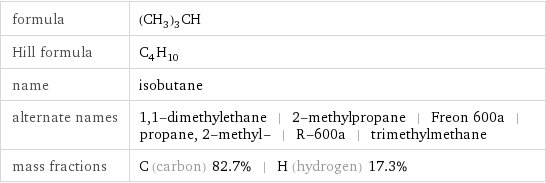
formula | (CH_3)_3CH Hill formula | C_4H_10 name | isobutane alternate names | 1, 1-dimethylethane | 2-methylpropane | Freon 600a | propane, 2-methyl- | R-600a | trimethylmethane mass fractions | C (carbon) 82.7% | H (hydrogen) 17.3%
Lewis structure
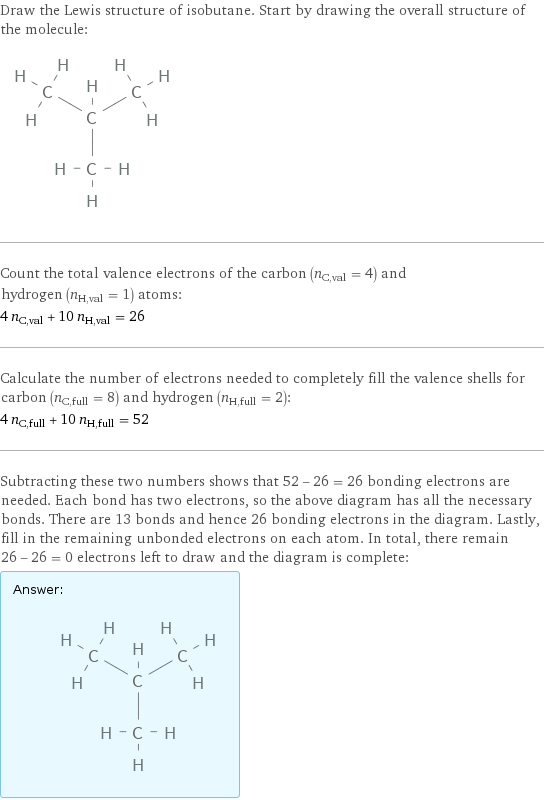
Draw the Lewis structure of isobutane. Start by drawing the overall structure of the molecule: Count the total valence electrons of the carbon (n_C, val = 4) and hydrogen (n_H, val = 1) atoms: 4 n_C, val + 10 n_H, val = 26 Calculate the number of electrons needed to completely fill the valence shells for carbon (n_C, full = 8) and hydrogen (n_H, full = 2): 4 n_C, full + 10 n_H, full = 52 Subtracting these two numbers shows that 52 - 26 = 26 bonding electrons are needed. Each bond has two electrons, so the above diagram has all the necessary bonds. There are 13 bonds and hence 26 bonding electrons in the diagram. Lastly, fill in the remaining unbonded electrons on each atom. In total, there remain 26 - 26 = 0 electrons left to draw and the diagram is complete: Answer: | |
3D structure

3D structure
Basic properties
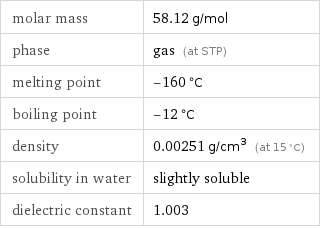
molar mass | 58.12 g/mol phase | gas (at STP) melting point | -160 °C boiling point | -12 °C density | 0.00251 g/cm^3 (at 15 °C) solubility in water | slightly soluble dielectric constant | 1.003
Gas properties (at STP)
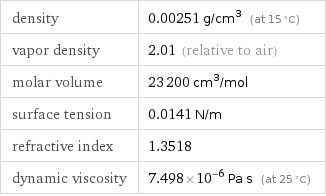
density | 0.00251 g/cm^3 (at 15 °C) vapor density | 2.01 (relative to air) molar volume | 23200 cm^3/mol surface tension | 0.0141 N/m refractive index | 1.3518 dynamic viscosity | 7.498×10^-6 Pa s (at 25 °C)
Units

Thermodynamic properties
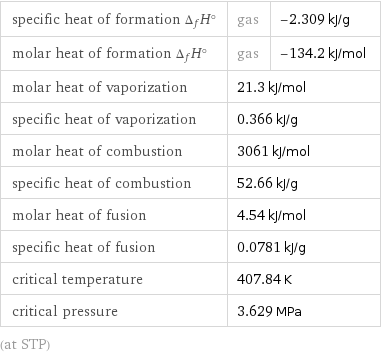
specific heat of formation Δ_fH° | gas | -2.309 kJ/g molar heat of formation Δ_fH° | gas | -134.2 kJ/mol molar heat of vaporization | 21.3 kJ/mol | specific heat of vaporization | 0.366 kJ/g | molar heat of combustion | 3061 kJ/mol | specific heat of combustion | 52.66 kJ/g | molar heat of fusion | 4.54 kJ/mol | specific heat of fusion | 0.0781 kJ/g | critical temperature | 407.84 K | critical pressure | 3.629 MPa | (at STP)
Phase diagram

Phase diagram
Units

Chemical identifiers
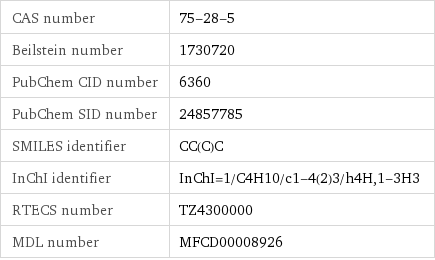
CAS number | 75-28-5 Beilstein number | 1730720 PubChem CID number | 6360 PubChem SID number | 24857785 SMILES identifier | CC(C)C InChI identifier | InChI=1/C4H10/c1-4(2)3/h4H, 1-3H3 RTECS number | TZ4300000 MDL number | MFCD00008926
NFPA label

NFPA label
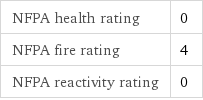
NFPA health rating | 0 NFPA fire rating | 4 NFPA reactivity rating | 0
Safety properties

flash point | -107 °C autoignition point | 460 °C lower explosive limit | 1.8% (concentration in air) upper explosive limit | 8.4% (concentration in air)

DOT hazard class | 2.1 DOT numbers | 1969
Toxicity properties

RTECS classes | other